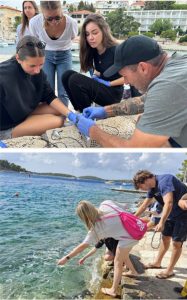
Pharos Institute and Boz Institute completed the field research of the pilot program. During September, seven high school juniors and a science teacher from Hvar, and four scientists from Boz Institute (Figure 1) deployed 16 environmental sensors in the sea in and around Stari Grad, Hvar, and several other locations on the island in late September (Figures 2 and 3). These sensors (Composite Integrative Passive Samplers / CIPS) deployed for ten days, capture both water- and lipid-soluble chemicals and are used to characterize > 600,000 known chemicals, including many carcinogens, mutagens, and persistent organic industrial pollutants. Our goal is to assess sea water quality around the Island and test for presence of industrial chemicals (polychlorinated biphenyls, polyaromatic hydrocarbons, plasticizers, and other toxicants).

Figure 2. Deployment sites (16 blue pins) indicate locations of deployed chemical sensors around the Island of Hvar.

Besides sea water chemical profiling, our team took numerous sea water measurements (pH, salinity, temperature, dissolved oxygen, conductivity / salinity) and collected both bay mussels and sea urchins at each site (Figure 4): the animal tissues were dissected (Figure 5) and prepared for the chemical content analysis and metagenomic sequencing, quantifying the presence of bacteria, viruses, parasites, and other microbes. Pending our chemistry and microbiology results, several animal tissues will be used for selected genes’ and enzymes’ expression profiling.


Hvar students and the Boz team will continue to work virtually, processing and normalizing the data, performing statistical analysis, and preparing the manuscript for a submission to a peer-reviews scientific journal by the late winter / early spring 2025.
This pilot project has been generously supported by the Mayors’ offices from Hvar and Stari Grad, and the Island of Hvar Nautical Center. Funding for research is provided by Statera, Inc (North Carolina, U.S.), and Boz Life Science Institute (San Diego, U.S.), and the Matko and Vera Miličić Foundation, Hvar.
